Zircon contains trace amounts of uranium, which means that scientists can use them to date rocks. The oldest rock-bearing zircon is known to be 4.4 billion years old.
5% off your first order!
Gemstone Guide

Alexandrite is fossilized tree resin and therefore what is known as an ‘organic gemstone.’ Some amber is around 360 million years old.

Alexandrite
Alexandrite is fossilized tree resin and therefore what is known as an ‘organic gemstone.’ Some amber is around 360 million years old. It is known for having ‘inclusions’ of insects and sometimes even prehistoric animals.
Stone Age man thought amber had supernatural properties; the ancient Greeks believed that amber was the tears of the Halides, mourning the loss of their brother, which had been dried by the sun. In the middle ages, amber was burnt as its scent as thought to possess the power to draw illness from the body and alleviate pain.
Amber from the Baltic States is older and therefore more desirable, as is amber with inclusions. It is also mined in the Dominican Republic.
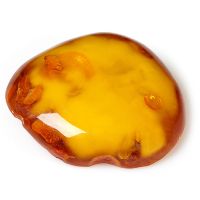
Amber is fossilized tree resin and therefore what is known as an ‘organic gemstone.’ Some amber is around 360 million years old.

Amber
Amber is fossilized tree resin and therefore what is known as an ‘organic gemstone.’ Some amber is around 360 million years old. It is known for having ‘inclusions’ of insects and sometimes even prehistoric animals.
Stone Age man thought amber had supernatural properties; the ancient Greeks believed that amber was the tears of the Halides, mourning the loss of their brother, which had been dried by the sun. In the middle ages, amber was burnt as its scent as thought to possess the power to draw illness from the body and alleviate pain.
Amber from the Baltic States is older and therefore more desirable, as is amber with inclusions. It is also mined in the Dominican Republic.

A beautiful deep violet purple variety of the mineral quartz, and the most well known and most prized variety.

Amethyst
A beautiful deep violet purple variety of the mineral quartz, and the most well known and most prized variety. Top quality amethyst features deep, rich and even colour and is free of inclusions.
In many cultures and throughout the ages, amethyst has been said to protect the wearer from many problems such as the powers of seduction, drunkenness (Greek words ‘amethystos’ meaning ‘not intoxicated’) locusts, aid in the winning of wars, help against insect bites and stomach acid.
Amethyst can be found being mined in Brazil, Uruguay, Sri Lanka, Siberia, Canada, India, Bolivia, and Argentina and in the USA, though most amethyst comes from Zambia.

Ametrine is also known as trystine or by trade name ‘bolivianite’, a naturally occurring variety of quartz.

Ametrine
Ametrine is also known as trystine or by trade name ‘bolivianite’, a naturally occurring variety of quartz. It’s a mixture of an amethyst and citrine with zones of purple and yellow or can even have a tinge of orange. Ametrine can also be cut to blend the two colours so that the result is a mixture of yellow, purple, and peach tones throughout the stone. A 50/50 split ametrine with a deep golden yellow and dark purple color with a sharp transition is considered the highest quality and can be quite expensive.
This is also popular among artistic cutters and carvers, who play with the colours, creating landscapes in the stone. Ametrine is mined in Bolivia, although there are deposits being exploited in Brazil and India.

Andalusite is an aluminium silicate that derives its name from the southern Spanish province of Andalusia.

Andalusite
Andalusite is an aluminium silicate that derives its name from the southern Spanish province of Andalusia. Andalusite is typically yellow, yellow-green, green, brownish red, olive and reddish brown. While andalusite’s colour play has been compared to alexandrite, this is technically not true, as it is pleochroic rather than colour changing. Prized for its strong pleochroism, it displays different colours in different directions and features all of its colours at once, whereas true colour-change gems like an Alexandrite only changes colour when exposed to different sources of light.
Andalusite is mined in many locations, including Australia, Brazil, Canada, Russia, Spain (Andalusia), Sri Lanka, Burma, Madagascar and the USA (California and Colorado).

Aquamarine is one of the most well known gemstones on the market today and has been mined for over 2,000 years.

Aquamarine
Aquamarine is one of the most well known gemstones on the market today and has been mined for over 2,000 years. It is a turquoise or sky blue coloured variety of the mineral species beryl, and part of the same family as emerald, morganite and red beryl. Its beautiful blue colour is what coined the gemstone’s name ‘aqua marina’ meaning ‘water of the sea’ in Latin.
In Ancient Greece, people believed that aquamarine would keep the blue sea calm and protect the wearer from storms. It was also believed that aquamarine could quicken the intellect. In modern gemstone therapy, aquamarine is considered a gemstone of friendship and loyalty. Aquamarine was very popular in jewellery in the early 20th century and remains popular to this day.
Aquamarine is mined at high elevations in Pakistan’s Karakoram Mountains, up to 15,000ft. It is also mined in Brazil and West Africa.
The largest faceted aquamarine is known as the ‘Don Pedro Aquamarine’ and weighs a massive 10,363 carats. The stone is now housed at the Smithsonian Institute in Washington D.C, USA.

Cat’s Eye Chrysoberyl is often shortened to ‘Cat’s Eye,’ and is usually a pale golden yellow, green or brown.

Cat’s Eye Chrysoberyl
Cat’s Eye Chrysoberyl is often shortened to ‘Cat’s Eye,’ and is usually a pale golden yellow, green or brown. It is most commonly cut into a cabochon to show chatoyancy; an effect caused by light reflecting from fine needle like inclusions in the gemstone creating a bright ray of light across the surface which moves when the gemstone is moved.
Despite its name, Cat’s Eye is not part of the ‘beryl’ gemstone family, which includes emerald and aquamarine. Since ancient times, the Cat’s Eye has been seen as a gemstone that protects the wearer as a good luck talisman. In modern gemstone therapy, Cat’s Eye is associated with the characteristics of discipline, faculty and wealth and is often associated as being good luck for those born under the star sign Leo.
Cat’s Eye is mainly mined in Brazil, Sri Lanka, Zimbabwe, Madagascar and Myanmar. Sri Lanka is home to the top quality.
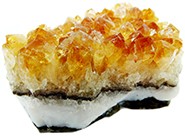
The word citrine derives from the Greek word ‘citron’ meaning lemon. Citrine is rather a rarity in nature.

Citrine
The word citrine derives from the Greek word ‘citron’ meaning lemon. Citrine is rather a rarity in nature. It was discovered in the mid 1700s that carefully heating amethyst (and sometimes smoky quartz) at around 500°C causes the stone to turn yellow. Whilst this occurs less frequently in nature, treatment is so common, that most of the citrine on the market is heated amethyst or smoky quartz. Natural citrine with a strong yellow to reddish saturation with no brown tint is the most valuable. Since its discovery, citrine has been associated with the ability to dispel sadness and increase fertility.
The top sources for natural citrine are Bolivia, Spain, Madagascar, Mexico and Uruguay. Amethyst that is typically heat treated to create citrine is mostly mined in Brazil.
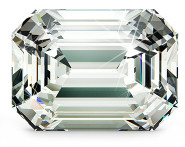
Derived from the Greek meaning ‘unbreakable’, diamond is a mineral, considered to be the most beautiful and rare of all gemstones.

Diamond
Derived from the Greek meaning ‘unbreakable’, diamond is a mineral, considered to be the most beautiful and rare of all gemstones. Diamond has been associated with love for centuries.
The most prized and valuable of all gemstones, a diamond takes between 1 and 3.3 billion years to grow. It is unique because it is made from one single mineral – carbon – and needs a unique environment of heat and pressure in which to grow. This environment is created by the Earth at depths of between 87 and 118 miles below the surface, where the pressure is around 45-60 kilobars and the temperature approximately 900-1300°C. Interestingly, graphite, or pencil lead, is also made from carbon, but it is the specific environment that causes carbon to form a unique chemical structure to create diamond.
The word ‘diamond’ derives from the Greek ‘adamas,’ meaning ‘unbreakable.’ The stone was first mined in India around 6,000 years ago, where it was revered for its beauty (its unique way to interact with light) and its unique physical properties (hardness and durability). During these times, diamond was only allowed to be worn and used by kings and in religious ornamentation – such as in Hindu Idol statues. As a result of their unique properties, diamonds were thought to have supernatural powers, that they could ward off evil and had the ability to heal; their beauty being that only something a divine being could create. Indeed the ancient Greeks believed that diamonds were the tears of the gods. It is only relatively recently (in historical terms) that diamonds have become more accessible to those in society, though top quality diamonds and the creations of the haute diamond jewelers – such as Cartier, are still only affordable by the wealthy. Worn by movie stars and glamour girls, diamonds represent wealth, success and power like no other stone can.
Diamonds as engagement rings
Despite many believing that a diamond being given as an engagement ring is a relatively modern phenomenon resulting from the successful advertising campaigns of DeBeers and Tiffany&Co, the first prominent and well documented diamond engagement ring was given back in 1477 by Archduke Maximilian of Austria to Mary of Burgundy. However, historians have traced the practice back to ancient Rome; the Romans valued diamond for its supernatural powers and it later Italians believed that a diamond would cause source for a long and happy marriage.
Diamond Grading
In the 1950s GIA (the Gemological Institute of America) invented the diamond grading scale. The best colour will be graded as a ‘D’ colour – this means that the diamond is completely colourless (note, not white). However, with coloured diamonds, the best quality coloured diamonds will be described as having a vivid to intense saturations of the diamond colour (pink/yellow/blue etc).
The best diamond will also be ‘flawless’. This means that the stone has absolutely no imperfections (known as inclusions) either on the inside of on the surface of the stone (not even one tiny polish mark). These stones are exceptionally rare and demand extremely high market prices, especially in larger sizes.
Where is Diamond mined?
Until the Spanish Conquistadors discovered diamond in mines in Brazil in the 16th century, diamond was only mined in India. Today, diamond is mined the world over, in Canada, Russia, Australia, Botswana, South Africa, Namibia, Sierra Leone and Lesotho. It is suggested that around 150 million carats are being mined each year.
Fancy Diamonds
Traditionally diamond is ‘colourless’ – this is often referred to as ‘white’. However diamonds can be many different colours including yellow, pink, blue, red, orange, grey, black, green, purple and brown. Coloured diamonds are known as ‘fancy coloured diamonds’ or sometimes just as ‘fancies’ such as a ‘fancy yellow’.
A Diamond is Forever
Named the best advertising slogan of the twentieth century, ‘A diamond is forever’ was inspired by the natural resistance diamond has to scratching and breaking. The slogan was coined by a young copywriter – Frances Gerety in 1947. Although the notion wasn’t a new one, with Anita Loos expressing similar notions in her 1925 book ‘Gentlemen prefer Blondes’; ‘…American gentlemen are the best after all, because kissing your hand may make you feel very very good but a diamond (and Sapphire) bracelet last forever’ the slogan became one of the most iconic advertising campaigns ever, for the DeBeers diamond company, who monopolized the diamond markets throughout the twentieth century.
An Exceptional Diamond
The most famous diamond in the world, the Cullinan Diamond is the largest gem-quality diamond ever found, at 3106.75 carats (rough). It was found in 1905, in the Premier No.2 mine near Pretoria in South Africa. Nine diamonds were cut from the Cullinan, the largest of which is known as the Great Star of Africa and, at just over 530 carats, the stone sits in the Sceptre with the Cross, part of the Crown Jewels of the United Kingdom. Interestingly the stone, once cut, was sent via parcel post to the UK from South Africa!

One of the most beautiful and valuable gemstones (along with ruby and sapphire), historians have estimated that emeralds have been mined since the 4th century BC.

Emerald
One of the most beautiful and valuable gemstones (along with ruby and sapphire), historians have estimated that emeralds have been mined since the 4th century BC. The beauty and enchanting nature of the emerald has been witnessed throughout history. The colour green has long been associated with the beginnings of life and springtime. In ancient Rome, green was the colour associated with the goddess Venus – the goddess of beauty and love and so emerald was worn or given to symbolize these virtues.
Today, emerald is the world’s most popular green stone, with ever increasing demand for its top shades. Unlike most other gemstones, even in top quality/colour stones, inclusions are tolerated. Due to the nature of their growth emeralds often have many fractures. Emerald fractures are often filled with oil or resin; this is an age-old practice which makes the inclusions less severe to the naked eye.
Egypt was the only known source for emeralds until the 16th century, when Spanish conquistadors discovered an abundance of the minerals in mines in Brazil. Today, the most desirable emeralds come from Colombia. However, emeralds of equal quality are being mined in South America, Central and Eastern Africa, Pakistan, Madagascar, Afghanistan and Central Asia, including Russia.
The worlds’ largest single emerald crystal sits in what is known as the Bahia Emerald. A host rock from the Brazilian state of Bahia was found in 2001 and weighs an astonishing 840lbs. The rock has been valued at over $400 million and has caused controversy since its finding, having been called ‘intoxicating’, the emerald has been sold in a Sao Paulo car park, was stolen in 2008, has shown up on eBay (with a ‘buy now’ price of $75 million) and narrowly missed complete destruction when it spent two months under water in New Orleans, as a result of Hurricane Katrina. The rightful owner of the emerald is still being decided by judges in America and is being held in storage by the Sheriffs Department in Los Angeles.
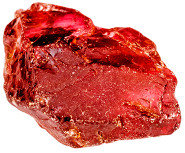
Garnet is a gemstone family consisting of many different gemstones of different chemical composition.

Garnet
Garnet is a gemstone family consisting of many different gemstones of different chemical composition. Names of some popular garnets include rhodolite, pyrope, spessartite, almandine, demantoid, grossularite, andradite, and uvarovite.
Traditionally red, garnet has been known to man since ancient times, having been found in early Egyptian and Roman jewellery. Like other gemstones such as citrine, garnet was seen as a protective stone and talisman as they were thought to have a uniquely luminous quality. In these times red garnets were referred to as ‘carbuncle’, which means ‘burning charcoal’ in Latin. Pharaohs were buried with the stones to ward off evil in the afterlife and it is said that Noah used a light made of garnet to guide his Ark through the dark nights. In the middle ages red garnet was popular with nobility as it was thought to bring prosperity.
Garnets are very popular in antique, especially Victorian, jewellery. Garnet can be the most beautiful bright orange, green, yellow red and purple, in top quality stones. As a result of their rich and varied colour spectrum, garnet is a gemstone that can keep up with changing colour trends and they are relatively low price per carat (in comparison to ruby for example). Tiffany & Co. amongst other popular jewellers have more recently introduced different garnets into their collections in an attempt to re-introduce the stone to the modern gemstone market.
One of the most expensive garnets in the world is the rare Demantoid Garnet. It was originally found in the Ural Mountains in Russia, in 1851. It is still largely only these stones which show the rare ‘horsetail inclusions’. Stones with these inclusions can demand huge prices at auction. Until the 1500s, garnet was largely mined in Bohemia, now it is mined in Tanzania, Sri Lanka, India, Central America, Brazil and Russia.
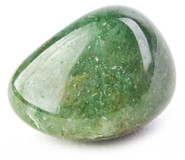
Jade can be either of two different minerals – jadeite or nephrite – both are referred to and accepted as ‘jade’.

Jade
Jade can be either of two different minerals – jadeite or nephrite – both are referred to and accepted as ‘jade’. The history of jadeite is as old as Chinese civilization. Jadeite sculptures and tools as old as 7000BC have been found by archaeologists. Confucius wrote that ‘…the wise have likened jadeite to virtue’ and that the stone represented purity, intelligence, justice, loyalty, sincerity and chastity amongst other qualities. The Chinese symbol for jade ‘yu’ means ‘the royal gem’. There is evidence that the ancient Aztecs and Incas of Central America valued jade as highly as gold, the ancient Egyptians believed it to be a stone of love and harmony and early American Indians believed that it could cure kidney problems. In modern gemstone therapy, jade is thought to stimulate energy and balance.
Jade is mined in China, Canada, Guatemala, Myanmar and New Zealand. It is often streaked or mottled, which can give it the perfect optical pattern for carving. It can range from translucent to entirely opaque and is commonly treated to improve the luster of the surface appearance. Pure, even, bright, slightly yellow or bluish green is still the most desirable colour, known as ‘imperial jade’ can demand millions of pounds in the gemstone market. The most highly valued transparency is ‘semi transparent’ – the most translucent jade can be. An even and smooth texture is desired (no mottling). This texture is known as ‘old mine’.
Prince Alexis Mdivani of Georgia gave Barbara Hutton a beautiful jade necklace to celebrate their nuptials in 1933. The necklace consists of 27 strikingly perfect round jade beads, all cut from the same boulder, complete with a Cartier designed diamond and ruby clasp. This amazing piece reached a record price for jade at the Sotheby’s auction in Hong Kong in April 2014, where the necklace sold to Cartier, for an astonishing $27.44 million.
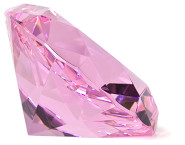
Kunzite is a violety-pink variety of the mineral species spodumene.

Kunzite
Kunzite is a violety-pink variety of the mineral species spodumene. It is a relatively new gem, being discovered in San Diego, California, by Tiffany & Co.’s chief gemologist and New York jeweller, George Frederick Kunz, in 1902, after whom the gemstone is named. Kunzite is mined in America, Afghanistan, Madagascar and Brazil.
Kunzite suffers somewhat from lack of consumer recognition. However, like with garnet this can commute to affordable over the counter prices for the gem. It exhibits special appeal because of its delicate pinkish hues. Special care is taken when cutting kunzite because the stone is strongly pleochroic, additionally special care should be taken when wearing/keeping kunzite as prolonged exposure to light and heat can cause the stone to fade. As a result of its rarity, darker and more saturated pinks are the most valuable. In addition, in most cases, a bright and inclusion free stone is preferable.
In modern gemstone therapy kunzite is said to be a popular healing stone, one which enhances love and devotion and bestows inner peace on the wearer and keep depression at bay.
Kunzite is often found in large sizes. The Smithsonian Institute in Washington houses the largest known kunzite in the world. At 880 carats, the kunzite has been fashioned into a beautiful heart shaped stone.
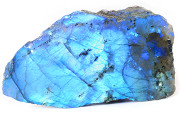
Labradorite is a gemstone named after its place of discovery – Labrador, Canada.

Labradorite
Labradorite is a gemstone named after its place of discovery – Labrador, Canada. It is also mined in Madagascar and Finland. It is a gemstone that displays a phenomenon known as ‘labradorescence’, iridescent play of colour, where stunning metallic colours are displayed across the surface of the gemstone – caused by microscopic layers within the gemstone, and their different interactions with light. However, not all labradorite displays this phenomenon, in its simplest form, labradorite is a dark looking grey.
Missionaries in Canada first discovered labradorite in the 1700s, and it was first introduced to the European market around 1770. However, Innuit Eskimos have long known about this gemstone, and some pieces as old as 3000 years have been found. The Eskimo myths associated the labradorescence with the Northern Lights, which they believed were captured inside the stone. In modern day, labradorite is actually used as a decorative material – in building and carvings for example. In modern gemstone therapy, labradorite is associated with clarity, of the heart and of the mind; the stone is thought to enhance perception and intuition.
The most desirable and expensive labradorite is a specific variety known as ‘spectrolite’. Spectrolite is largely only mined in Finland. It displays spectral colours in fiery yellows, oranges and reds as well as bright greens and blues.
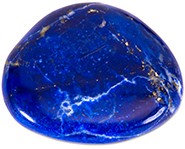
Lapis lazuli is a deep midnight blue opaque gemstone, which is often speckled with golden and white flecks.

Lapis Lazuli
Lapis lazuli is a deep midnight blue opaque gemstone, which is often speckled with golden and white flecks. For ancient civilizations this gemstone represented the magic of the night sky. The name is derived from the Latin ‘lapis’ meaning ‘stone’ and the Arabic ‘azula’ meaning ‘blue’. Lapis lazuli is actually an aggregate of several minerals – lazurite, calcite and pyrite. It is calcite and pyrite that cause the flecks of white and gold respectively.
The ancient civilizations of Mesopotamia, Persia, Egypt, China, Greece and Rome treasured lapis for its natural vivid royal blue colour, which Alexander The Great referred to as ‘ultramarine’ translating as ‘from beyond the sea’. In modern gemstone therapy lapis lazuli is regarded as a gemstone of truth and friendship.
Top quality lapis has a rich deep royal or midnight blue colour (no hint of green) with a smooth, lustrous texture, with no flecks of calcite (white) and either no or very small evenly spread gold-coloured pyrite flecks. The best quality and most desirable lapis has always come from the steep Hindu Kush in Afghanistan.
The Lapis was originally mined in the Sar-e-Sang deposit in remote Afghanistan, where they have been mining for around 6,500 years. Mines are also in Russia, Chile, Colorado and Burma. Lapis is often mined in the harshest of environments, at altitudes of around 14,000ft in the mountains. One might imagine what a feat this may have been for ancient civilizations to achieve.
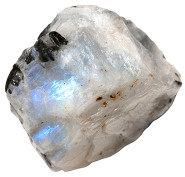
Traditionally cut as a cabochon, moonstone is the most familiar of all the members of the feldspar group of minerals, alongside other gemstones such as labradorite.

Moonstone
Traditionally cut as a cabochon, moonstone is the most familiar of all the members of the feldspar group of minerals, alongside other gemstones such as labradorite. Moonstone is notable because it displays a unique phenomenon known as adularescence, which makes the surface of the gemstone seem to glow with a enchanting misty white blue colour which dances across the stone when moved and viewed from different directions.
In the worlds first encyclopedia – written by Pliny the Elder in 20-79 AD, moonstone is referred to as ‘astrions’ meaning star stone. Throughout history moonstone has been surrounded by mystique and magic. However, moonstone has probably been most popular during recent centuries, enjoying surges of popularity most notably in the Art Nouveau period, where Rene Lalique and Louis Comfort Tiffany used the gemstone in their jewellery and during the 1960s-70s ‘hippie’ movement, where moonstone gave its wearers its desired celestial look.
The best quality moonstone will be colourless, nearly transparent, with no inclusions and will display a vivid blue adularescence, known as ‘blue sheen’ in the trade. The best quality Moonstone is traditionally from Sri Lanka. It is also mined in USA, India, Brazil, Madagascar, Australia and Myanmar.
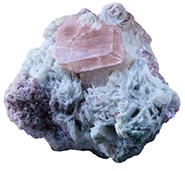
Morganite is a pink coloured variety of the mineral species beryl, alongside emerald and aquamarine.

Morganite
Morganite is a pink coloured variety of the mineral species beryl, alongside emerald and aquamarine. Discovered on the African island of Madagascar, Morganite was named after the famed mineral collector and banker, John Pierpont Morgan, a good customer of Tiffany & Co, and it was their chief Gemologist who decided that the gemstone be his customers namesake. Only discovered in 1911, Morganite is a relatively new gem on the market and has been promoted most notably by Tiffany & Co throughout the last century. Morganite is a beautiful orange pink colour (or more rarely and valuable, a deep magenta) and in modern gemstone therapy, it is thought to reduce stress and represent charm and tenderness.
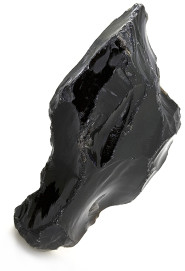
Onyx is a variety of the chalcedony species of gemstone, part of the quartz group or family.

Onyx
Onyx is a variety of the chalcedony species of gemstone, part of the quartz group or family. It is a black gemstone that occasionally has bands of white running through it. Chalcedony which is banded black and white with reddish brown is known as ‘Sardonyx’.
The name comes from the Greek word ‘onyx’ meaning ‘nail’ or ‘claw’. In Greek mythology, all chalcedony was called Onyx and it was thought that the gemstones were the fingernails of Venus, and the stone was thought to assist in the growing of hair and nails. However, it was the Romans who first referred to black chalcedony as simply being onyx. In modern gemstone therapy onyx is said to represent inner strength and mental persistence and self-control.
Onyx is a relatively inexpensive gemstone and is largely used for carvings and cabochons as a result of its fine texture and the white banding in onyx makes it perfect for relief work such as with cameos. It is mined mostly in the USA, Madagascar, Brazil, India, Pakistan and Sri Lanka though there are other notable deposits worldwide.

The word opal is derived from the Sanskrit ‘upala’ meaning ‘precious stone’.

Opal
The word opal is derived from the Sanskrit ‘upala’ meaning ‘precious stone’. Opal can display a phenomena called ‘play of colour’, which means the gemstone shows broad flashes of colour which appear and disappear when the stone is moved. This type of opal is often described as ‘precious opal’. Opal which displays no ‘play of colour’ is known as ‘common opal’.
The first recordings of opal are from around 50BC, when the stone was being traded down the Danube to the Greek city of Corinth and to Rome. At this time, Opals were being mined in Slovakia and Hungary. From 1869 large deposits were found across Australia (and today they are mainly mined here and in Mexico). At this time opal became a very spiritual stone for the Aboriginals, as it was associated with the multi-coloured ‘rainbow serpent’ which represented protection. Opal is made up of compressed silica spheres and is composed of between 5-15% water. Opal has an amorphous structure which means its crystal structure is without a definite shape.

Pearls are organic substances and each one is unique. They have been coveted through the ages for their beauty as symbols of wealth and status.

Pearl
Pearls are organic substances and each one is unique. They have been coveted through the ages for their beauty as symbols of wealth and status. A Chinese historian recorded the oldest known reference to a pearl in 2206 BC and pearls have been found in aboriginal grave mounds. The Renaissance kings and queens were renowned for their love of pearls: King Henry VIII adorned his robes with them and his daughter Mary Tudor owned the most famous pearl in history – La Peregrina (‘The Pilgrim’).
The most desired natural pearls came from the Persian Gulf, the waters of Ceylon (now Sri Lanka), Chinese rivers and lakes and some rivers in Europe. Pearl formation process begins when a foreign body enters a mollusc (usually an oyster or mussel) and is coated with nacre as a natural defence. Due to many factors the natural pearl market declined after 1900. Today 99% of Pearls are cultured and are grown around the world in saltwater oysters and freshwater mussels. There are eight types of pearl: natural, south sea, akoya, Tahitian, freshwater, keshi, seed and mabé. Generally speaking, only around 2% of freshwater pearls are spherical.
Pearls can be white, cream, yellow, black, blue, pink and green. Pearl colour is always a combination of colour and overtone. The overtone is translucent and changes or adds depth to the body colour of the pearl. Pink overtone is the most popular.
Cultured Pearls
Records show that the Chinese were farming freshwater cultured pearls as far back as the 1200s. Pearl culturing is an adaptation of the natural pearl formation process. When Pearls are cultured humans insert the foreign body to stimulate pearl growth themselves. Humans imitate and control the natural process and also control the environment of the mollusk shells growing the pearl. Types of cultured pearls: Akoya, South Sea, Tahitian and Freshwater.
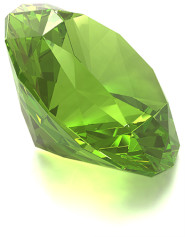
Peridot is a beautiful, bright gemstone form of the mineral olivine. It is relatively inexpensive and also quite plentiful.

Peridot
Peridot is a beautiful, bright gemstone form of the mineral olivine. It is relatively inexpensive and also quite plentiful. It is usually transparent and one of the few gemstones to come in only one colour – green. The word peridot comes from the Arabic ‘fairdat’ meaning ‘gem’ and the Greek ‘peridona’ meaning ‘to give richness’. Due to its beautiful grass green colour, peridot has also been associated with spring, wealth, prosperity and holiness.
Peridot can be found in ancient Egyptian jewellery as far back as 2000BC and they referred to the gemstone as the ‘gem of the sun’ because of the way the stone stays bright and vivid, even in candlelight. This was also the reason that the Romans nicknamed peridot ‘the evening emerald’. In ancient times, peridot was used to treat illnesses of the gall bladder and it was a favourite of Josephine after Napoleon gifted her a peridot as a symbol of his adoration.
Christians throughout history have considered peridot sacred – a stone of lightness and beauty, a stone for the clear minded. As such, it was often used to adorn medieval churches and tombs and even today, catholic bishops wear rings of peridot and amethyst as symbols of purity and morality.
The best quality peridot is usually mined in Myanmar or Pakistan. It should be transparent, with no inclusions, a good luster and a bright, vivid lime green colour. A cat’s eye or star peridot is very rare, and very expensive. Also peridot in sizes larger than 5.00ct are quite rare and so correspondingly expensive.

Rose quartz is a pale pink variety of the mineral quartz which ranges in colour from near colourless to medium dark powder pink.

Rose Quartz
Rose quartz is a pale pink variety of the mineral quartz which ranges in colour from near colourless to medium dark powder pink. Rose quartz often has a number of inclusions, which, even at the stones most transparent will still give the stone a slightly milky/cloudy appearance. Rose quartz is cut either as a cabochon, or faceted if the material is particularly transparent. It is mined in India, Brazil, Madagascar and Sri Lanka.
In ancient times rose quartz was used as a token of love from around 600 BC and has always been a talisman for all types of relationships. In antiquity rose quartz was believed to bestow beauty and there is evidence that it was used as an early moisturizer or face mask to reduce wrinkles.
In modern gemstone therapy, rose quartz is said to open the heart chakra, and is thus associated with all types of love; rose quartz is said to bestow energy and enhance love in any situation. Emotionally rose quartz is used to bring calm and ease forgiveness and in crystal healing rose quartz is used to heal emotional wounds and overcome fear.

Ruby is the red variety of the mineral ‘corundum’, otherwise known as sapphire.

Ruby
Ruby is the red variety of the mineral ‘corundum’, otherwise known as sapphire. Red is the colour of fire and blood, and symbolises the emotions love, desire anger, passion and fury. Particularly in top quality, ruby is the rarest corundum, and the most valuable. In Sanksrit the name for ruby is ‘ratnaraj’, a word which means ‘king of the precious stones’. Ruby has been mined since the 8th century BC in Myanmar, Vietnam, Thailand, Sri Lanka, Pakistan, Laos, Nepal, Kenya and Tanzania.
The best quality rubies are known in the trade as ‘Burmese’. This does not necessarily mean that the ruby was mined in Burma (now Myanmar) but it is a reference to the top colour, which is also often also known as pigeon’s blood. This colour is a beautiful slightly bluish-red, with a silky appearance. If the stone does originate from Burma, this will also increase its price and desirability factor.
Often rubies can display a silky appearance, this is produced by a number of extremely small needle-like inclusions in the stone. Sometimes, these inclusions can be very numerous and can align in different directions within the stone and when cut in a cabochon, this produces the phenomenon ‘asterism’, which produces star like rays of light across the stone. These rare stones are known as star rubies.
The most famous star ruby in the world is the ‘Delong Star Ruby’. The stone weighs 100.32 carats, is beautifully translucent and shows a perfect six-rayed star. The ruby, along with the star of India, was the subject of an infamous burglary (carried out by surfing champion Jack Murphy) – the biggest jewel heist in American history at the Natural History Museum, New York – and was ransomed, alongside the star of India, for $25,000, in 1964. The stone was found safe after the ransom was paid in a Florida phone box.
The most expensive ruby in the world was sold at a Sotheby’s auction in April 2014, alongside the Hutton-Mdivani Jade necklace. The stone, originally mined in Burma, is set in a fantastic diamond ring and weighs 29.62 carats. A private bidder bought the ring for over $7 million.

Sapphire, like ruby, is a variety of corundum. Generally the term sapphire refers to the blue corundum, but sapphire also comes in many different colours such as yellow, pink, orange, green and purple.

Sapphire
Sapphire, like ruby, is a variety of corundum. Generally the term sapphire refers to the blue corundum, but sapphire also comes in many different colours such as yellow, pink, orange, green and purple. They also may be colourless or shades of grey and black. Sapphire is the rarest and most precious blue gemstone. Its name derives from the Greek ‘sapphiros’. Sapphire is made up of the three most abundant elements on earth – Aluminium, Oxygen and Silicon.
An ancient myth held that exposure to the sun caused sapphire’s glorious blue. The longer they ripened, the bluer they became. Moses was supposedly given the Ten Commandments on a tablet of blue sapphire making it the most sacred of gemstones.
Sapphire has more recently become popular as an engagement stone. A 12 carat oval Ceylon sapphire, is the centre stone of the engagement ring of Katherine Middleton and Prince William – previously worn by Diana Princess of Wales.
Sapphires can show a phenomenon called ‘Asterism’. Tiny inclusions form in the sapphire and produce star-like rays across the surface of the sapphire. Sapphires can also show a phenomenon called ‘colour-change’. Trace elements cause sapphire’s colours to change in daylight and fluorescent light.
Sapphires from Kashmir are said to have an unrivalled natural beauty. These sapphires are intense, velvety-blue colour termed ‘cornflower blue’. Blue sapphires with any amount of green as a secondary hue are not considered to be of fine quality. Grey is the colour that normally reduces the saturation or brightness of the blue, and has a distinctly negative effect.
The 423ct Logan sapphire of the National Museum of Natural History in Washington, D.C., is one of the largest faceted gem-quality blue sapphires in existence. Important Sapphire sources include Sri Lanka, Burma (Myanmar), Thailand, Cambodia, Madagascar, Tanzania, Australia, and the USA. The Kashmir region of India/Pakistan was famous for its Kashmir-blue Sapphire, but little material comes from there today. Sapphires from different geographic locations may have different appearances or chemical-impurity concentrations, and tend to contain different types of microscopic inclusions.

The word spinel is derived from the Italian ‘spinello’ meaning ‘joint’ or ‘spina’ meaning ‘thorn’.

Spinel
The word spinel is derived from the Italian ‘spinello’ meaning ‘joint’ or ‘spina’ meaning ‘thorn’. This it thought to be a reference to the stone’s rough shape – which in its perfect form is a sharp-edged octahedron. The gemstone is sometimes known as ‘Balas Ruby’ and is frequently confused with the gemstone ruby. Increasing demand for ruby alternatives rekindled appreciation for spinel’s rich red colour and history.
The Black Prince Ruby – given to Edward, the Black Prince in 1366 by the Spanish King is actually a 170 carat red spinel. The stone is set in the British State Crown and was believed to be a ruby until scientists discovered it was a spinel in the 19th Century.
Modern technology hasn’t helped spinel’s confused identity as far as the general public is concerned. This is due largely to the widespread use of synthetic spinel as an imitation for many other gems. Most customers aren’t even aware that there’s a natural version of the stone. Currently spinel is being mined in Tanzania, Sri Lanka, Myanmar, Vietnam and Tajikistan.
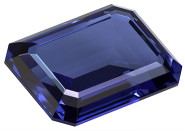
anzanite, a name coined by Tiffany & Co., is one of the most beautiful stones found in recent history.

Tanzanite
Tanzanite, a name coined by Tiffany & Co., is one of the most beautiful stones found in recent history. Its first discovery goes back only to 1967 when a Masai tribesman discovered the crystal in Northern Tanzania, Eastern Africa. To this day Tanzania is the only known source of tanzanite and the area in which they are mined covers only 4 square kilometres. Tanzanite can come in a variety of blues, violet and purple, and can also be brown. Only around 5% of the tanzanite crystals discovered are actually blue. Naturally the majority of tanzanite is brown. When heated the stone changes to a bright and stable glorious blue-violet.
Tanzanite displays distinct pleochroism, which means it shows different colours from different directions. The most desirable colour is a blue similar to a sapphire, however tanzanite also has a beautiful pleochroic violet-purple body colour.
The largest Tanzanite in the world is known as the ‘Queen of Kilimanjaro’ and is part of the private collection of Michael Scott, the first CEO of Apple.

Traditionally associated with the yellow of the sun the ancient Egyptians said that topaz was the stone of the sun god Ra.

Topaz
Traditionally associated with the yellow of the sun the ancient Egyptians said that topaz was the stone of the sun god Ra. Topaz was also one of the twelve scared breastplate stones of the high priests in the Book of Exodus. The name topaz supposedly derives from an island in the red sea, referred to in Roman times as ‘topazos’. In Sanskrit ‘topaz’ also means ‘fire’. In ancient Greece topaz was thought to increase ones physical and mental strength today topaz is said to represent mental harmony and balance.
The largest known topaz is the ‘American Golden Topaz’ and is 22,892 carats. Discovered in Brazil it is currently on display at the Smithsonian Institute in Washington D.C. The name ‘Imperial topaz’ is given to medium reddish orange coloured topaz. Topaz is largely being mined in Russia, Pakistan and Brazil.
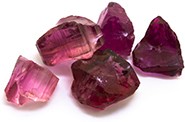
The word Tourmaline derives from the Sinhalese word ‘thuramali’ which means gemstones or pebbles.

Tourmaline
The word Tourmaline derives from the Sinhalese word ‘thuramali’ which means gemstones or pebbles. Tourmaline is known for the dazzling array of vibrant colours in which it is available. It has one of the widest colour ranges of any gem species, occurring in various shades of virtually every hue. In the 1500’s a Spanish conquistador confused a green tourmaline for emerald and scientists only recognized tourmaline as its own mineral in the 1800s.
The ‘watermelon’ variety of tourmaline is often considered the most exciting – being green on the outside and pink in the middle. Pink to red tourmaline is known as Rubelite, deep blue-green is known as Indicolite. Perhaps the most famous tourmaline is known as ‘Paraíba’ which is only found in the Brazilian state of the same name – it is a beautiful intensely saturated sea-blue.
Tourmaline is being mined in Brazil, Tanzania, Africa (largely Namibia, Madagascar and Kenya), Afghanistan, Pakistan, Sri Lanka and the United States.

First mined 5,000 years ago by Tibetans and Egyptians, turquoise’s colour can range from dull greys, to yellows, grass greens to bright sky blues.

Turquoise
First mined 5,000 years ago by Tibetans and Egyptians, turquoise’s colour can range from dull greys, to yellows, grass greens to bright sky blues. The most prized colour, a bright robins egg blue, comes from the Nishapur district of Iran. This is sometimes said to be ‘Persian Blue’.
Turquoise was popular in ancient Egypt – Cleopatra kept a collection of the gemstone, but it was in Turkey, Greece and Persia where it became the most popular. Turkey takes its name from the gemstone.
For the South-Western Native Americans, who have mined turquoise for over 1000 years, turquoise symbolized life-giving water and they saw the stone as a life-protecting force: they used turquoise on their weapons and guarded tombs with statues made of the gemstone.
Turquoise usually forms in limonite or sandstone – two stones which create veins of matrix within the stone. The less matrix, usually the more valuable the turquoise. However stones with many networks of matrix – known as spiderweb – is very valuable.
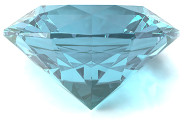
A gemstone largely known for its similarity with diamonds, Zircon has been mined for over 2,000 years, first found amongst gravel in Sri Lanka.

Zircon
A gemstone largely known for its similarity with diamonds, Zircon has been mined for over 2,000 years, first found amongst gravel in Sri Lanka. The name derives from ancient Persian ‘zargun’ which means golden-coloured. Zircon can be a multitude of autumnal colours as well as blue and colourless. Not to be confused with cubic zirconia, blue zircon was particularly popular in Victorian Britain, as it was known as a ‘stone of virtue’.

Find the right piece
Jewellery says something about the person who wears it, and at Farringdons, we can help you find the right piece for the right person.
